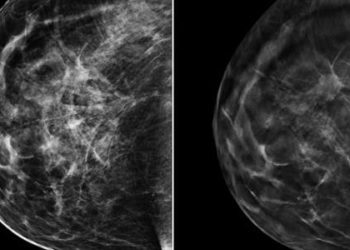The Scan by 2 Minute Medicine®: Mammogram Recommendation Changes, COVID Called Off, Canadian Wildfires, and National Nurses Week
5-15-2023
The Scan by 2 Minute Medicine® is a pop-culture medical newsletter and exclusive benefit for 2 Minute Medicine Plus subscribers.
Mammogram Recommendation Changes
The Story: The recommendations around breast cancer screening are changing as a result of emerging evidence on breast cancer risk in young people. The U.S. Preventive Task Force—the body that reviews evidence and develops recommendations on disease prevention—recently updated their guidance on breast cancer screening and now advises women to begin receiving biennial mammograms at age 40, rather than age 50. The guidelines change comes as a result of increasing in breast cancer diagnoses in people under the age of 50.
Cancer in Young People
People usually associate cancer with increasing age, but more and more research is showing an influx in diagnoses among young adults. Colon cancer has recently received attention for its increased prevalence in young people. But with a 2% increase per year from 2015 to 2019 in diagnoses in patients in their 40s, breast cancer is the latest disease to garner concern about its increased prevalence in young adults. The issue is not only that breast cancer is becoming more prevalent in younger populations, but also that the burden of disease is not distributed evenly. Research shows that younger Black women who are diagnosed with breast cancer have significantly worse survival outcomes than White women with the same diagnosis. This is in part explained by a higher proportion of Black women being diagnosed with aggressive forms of the disease, such as triple-negative breast cancer. But disparities in access to screening and treatment may also contribute to these differences. Improving screening measures, as with the new guidelines, and catching cancers early is one way to improving the survival outcomes in those diagnosed.
Screening and Overdiagnosis
Although the changes in mammogram guidelines are likely to find cancers earlier in young people, screening measures for cancers and other diseases come with inherent risks, such as overdiagnosis. Overdiagnosis occurs when a medical condition that would not have caused any harm is diagnosed and treated. When this happens, the patient is subjected to treatment and procedures that is often more harmful than the disease itself. Overdiagnosis is an issue of concern with many diseases. For example, estimates suggest that the overdiagnosis and overtreatment of prostate cancer can be as high as over 60%. Overdiagnosis remains a concern in breast cancer as well, although it is hard to quantify and may be overestimated. Therefore, whenever screening guidelines are expanded, as in the case of the recent breast cancer recommendations, the need to detect cancers early must be balanced by the risk of overdiagnosis. Rest assured that organizations like the U.S. Preventive Task Force take all of these factors into consideration when updating existing screening guidelines.
COVID Called Off
On May 5th, the World Health Organization (WHO) announced that COVID-19 is no longer considered a global health emergency. The news comes after evidence of decreasing trends in COVID-19 deaths, hospitalizations, and intensive care unit admissions. While restrictions have been loosening gradually over the past three years, the declaration from the WHO signals, for many, a formal end to the global pandemic. The U.S followed suit, declaring an end to the COVID-19 emergency status on May 11th. But what does all of this mean?
The WHO ensured that the downgrade in emergency status should not signal to countries to forget about COVID-19 altogether. The virus remains a “global health threat” according to the global health governing body. As we have seen in the past, the virus has the ability to mutate into novel and more dangerous strains. If this were to happen again, as we saw with the Omicron variant, it could trigger further precautions. However, the WHO suggests that countries should focus on long-term management of COVID-19, rather than emergency measures.
Practically speaking, the end of COVID-19’s emergency status has implications on vaccines, testing, and other healthcare measures. Public health data collection in the U.S is expected to end, and vaccine reporting is no longer required, which will make tracking cases and vaccine effectiveness harder. Although COVID-19 tests will no longer be free, safeguards are in place to ensure that vaccines will remain free for uninsured Americans through to December 2024. Many telehealth flexibilities will also remain in place until the end of 2024, while others, such as mental health services via telemedicine remain permanent. Although the pandemic has come to an end, its impact on the healthcare system will remain.
Canadian Wildfires
The province of Alberta, Canada recently declared a public emergency as a result of ongoing wildfires, forcing over 30,000 people to evacuate. As a result of global warming, wildfires are becoming increasingly common. In addition to immediate safety risks, these natural disasters can cause harm to both mental and physical health.
According to research, wildfires are the culprit of thousands of premature deaths every year. The deadly effects of wildfires are due, in part, to the toxic concoction of chemicals and substances, including carbon monoxide and soot, which are found in wildfire smoke. Most notably, wildfire smoke can have implications on the respiratory system, by exacerbating asthma and allergies, and on the cardiovascular system, by initiating heart attacks and strokes. However, wildfire smoke exposure has been associated with several other adverse health outcomes, including an increased risk of cancer, preterm birth, fungal infections, and poor mental health. Consequently, wildfire events are associated with increased emergency room visits, for things such as headaches, respiratory illness, cardiovascular events, and more. Listening to emergency officials in the event of a wildfire and limiting exposure to smoke can help reduce the risk of negative health effects.
National Nurses Week
Last week was National Nurses Week—a time to celebrate nurses and all they do. Nurses are the backbone of the healthcare system, providing care and support to patients at every point along their healthcare journey. Largely outnumbering doctors, there are over 3 million nurses in the U.S today. Despite this large number, the country is facing a significant nursing shortage.
Pre-pandemic estimates suggest that there was a global shortage of nurses and midwives of about 30 million. Since the pandemic, the shortage has only gotten worse and current estimates suggest that over 1 million new nurses will be needed in the U.S by the year 2030. Factors such as high turnover, low wages, burnout, and the ageing population have contributed to a greater demand for nurses and the current deficit. The nursing shortage represents a significant problem, which can lead to longer wait times, overcrowding in healthcare centers, decreased quality of care, and increased medical errors. Celebrating the important work of nurses and drawing attention to the current nursing shortage can help facilitate the development of innovative solutions for solving the nursing shortage crisis.
©2023 2 Minute Medicine, Inc. All rights reserved. No works may be reproduced without expressed written consent from 2 Minute Medicine, Inc. Inquire about licensing here. No article should be construed as medical advice and is not intended as such by the authors or by 2 Minute Medicine, Inc









